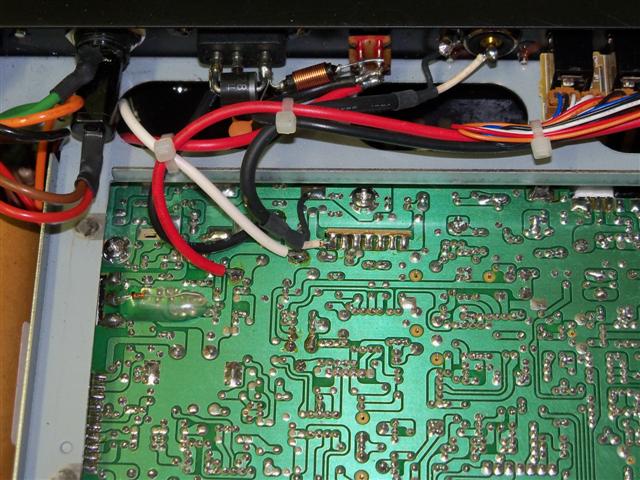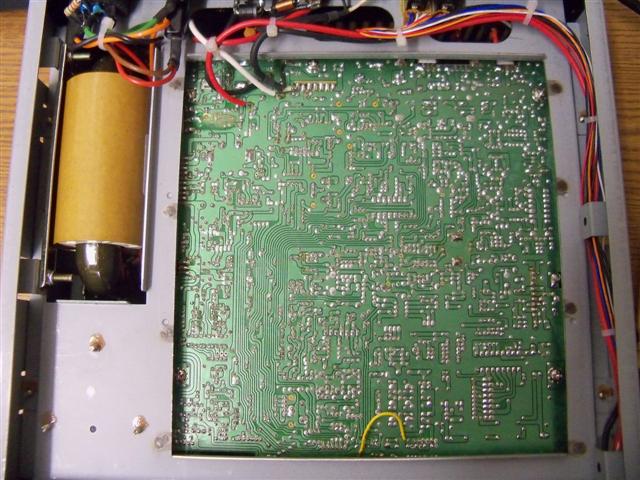Galaxy DX 2547 AM/SSB CB Radio Review
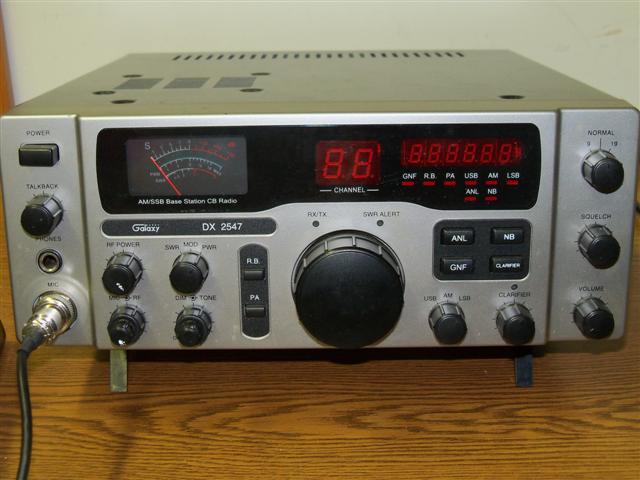
Back in the glory days of CB radio, when there were many millions of people using the radio daily, the radio companies were coming out with new base radio models every year. The Uniden Madison, Cobra 2000 GTL, Uniden Washington, and CPI CP2000 are just a few of those great models that were popular in the 80’s and 90’s and are still used across the United States today.
Fast forward to 2010 and the CB hobby is still going strong, but the manufacturers have placed almost all of their emphasis on mobile radios. Base radios are expensive and with a smaller market of consumers the manufacturers are trying to play it safe. The result is that there are very few CB base station radios being sold and for SSB your choices get narrowed even further.
While there were some recent attempts by a couple of companies to make SSB base stations (Cobra 2010 GTL and the Cherokee CBS-1000) both radios weren’t great performers and left hobbyists asking for something better. After all the dust had settled there were only two SSB base stations left on the market: the Ranger TR-696F and the Galaxy DX 2547. While the radios may look different, they are in fact very similar internally. These days the TR-696F is virtually impossible to find so the final chapter in CB base radios will likely be written by the Galaxy DX 2547.
LAST ONE STANDING
The Galaxy DX 2547 is the only AM & SSB CB Radio still widely sold across the United States. While there are a few export base stations still on the market the 2547 is the only FCC type certified CB base still available. The radio is manufactured for Galaxy by RCI so don’t be surprised when you look at the board and see Ranger stamped on it.
When you first see the Galaxy DX 2547 you’ll notice its styling is dramatically different than the older base radios from the 80’s & 90’s and it’s also very different than most of the large rack mount type base radios produced in recent years. The styling is similar to many of the ham radio base units and is more compact and streamlined.
The main features of the radio that set it apart from the older base stations are factory variable talkback, variable RF power, roger beep, and six digit frequency counter (yes I’m aware the 2000GTL had a six digit counter).
FEATURES & CONTROLS
Power on/off button
Variable talkback w/ off setting
Headphone jack
4 pin microphone connector
Variable RF power control
Microphone Gain
RF Gain
Large Meter with Power/Modulation/SWR readings
Switch for meter (SWR/MOD/PWR)
Variable Dimmer control
Variable Tone control (Hi/Low Tone)
Green/Red RX/TX light
LED Channel Display
6 Digit Active Frequency Counter (displays TX & RX)
Large centrally located channel knob
SWR Alert warning light
ANL – automatic noise limiter
NB – Noise Blank
GNF – Galaxy Noise Filter
Clarifier knob & button allowing to lock or unlock clarifier control
AM/USB/LSB switch to choose mode
Channel 9 or 19 switch
Squelch
Volume
LED indicator lights for GNF, RB, PA, USB, AM, LSB, ANL, NB
Looking at the left side of the radio you can immediately see the variable talkback control on this radio. it works well and allows you to adjust the amount from mild to quite loud. Many of those operators who like to try out different microphones or use echo will appreciate this feature. I did find that once the modulation in the radio was turned up and I added a powerful desk microphone that I would get feedback from the talkback if I turned it up even a hair, but that’s something we’ve run into many times with other models as well.
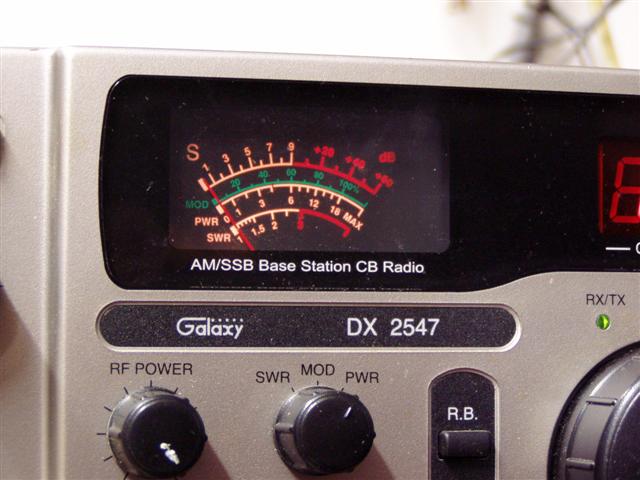
The typical large galaxy meter is present and is easy to read and just below is is the RF Power control. The variable RF power allows you to set the radio to a 1 watt deadkey (for those who like to run amplifiers) or up to 4 watts for full deadkey output. The variable power is smooth in it’s transition so it’s easy set it high or low or anywhere in between.

The roger beep on the radio is the standard beep you’ll hear on the Galaxy 959. The large channel changing control is something we’ve only seen on a couple of other CB base radios but it works quite well and gives a positive engagement as you turn through the channels. It seems strong and durable enough so I don’t foresee any reliability issues unless someone is really rough with it.
The six digit frequency counter will show the frequency the radio is receiving on and once you key the radio it will show the transmitting frequency. The counter is fairly accurate and seems as stable as most of the other frequency counters I’ve seen in CB radios. Something to note about the frequency counter – if you mod this radio for extra channels the frequency counter will show where you are operating (27.455, 27.555, etc).
Most people will be familiar with the other controls and functions so I’ll just mention one last one which is the GNF or Galaxy Noise Filter. This feature is supposed to reduce white noise on SSB and pull in stations that are hard to hear but after trying it out on multiple Galaxy radios I feel confident in giving my official feedback on this feature. It’s completely useless. In all my testing with Galaxy radios I’ve yet to find one where the GNF feature did anything beneficial. It could be there’s a problem with my ability to run a radio properly but I’m going to give my recommendation that people just leave the GNF off and don’t bother with it.
The speaker on the Galaxy DX 2547 is located on the top cover so the sound comes out the top of the radio. The speaker isn’t very large but it sounded very good in my shack, much better than the speaker on many mobile radios.
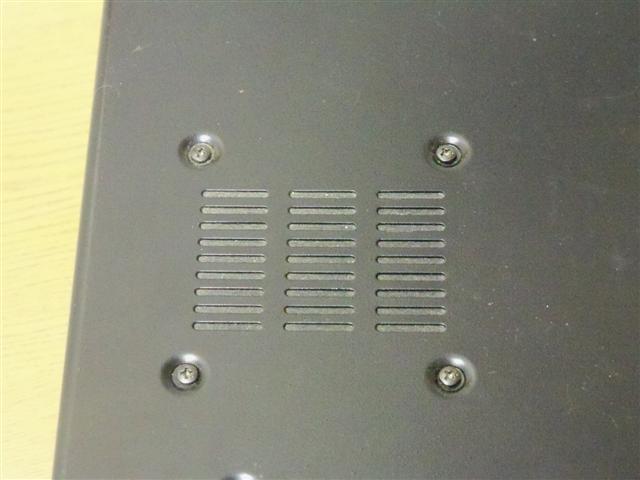
Looking at the back of the radio you can see where the standard 3 prong AC plug attaches and the large heat sink just above. The radio has a fuse at the back and a 12 VDC option if you want to run the radio in a RV or if the internal power supply ever kicks the bucket at least you have a backup option to run the radio.
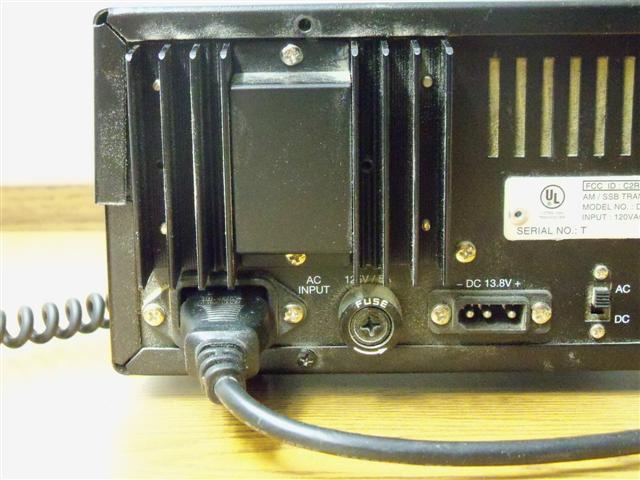
You can see the antenna jack, and the PA and external speaker jacks just to the right. On this particular radio you can see two red switches in the warning label area where extra frequencies were added to the radio. This radio does have multiple modifications that can be performed and adding additional frequency coverage is very simple to do.
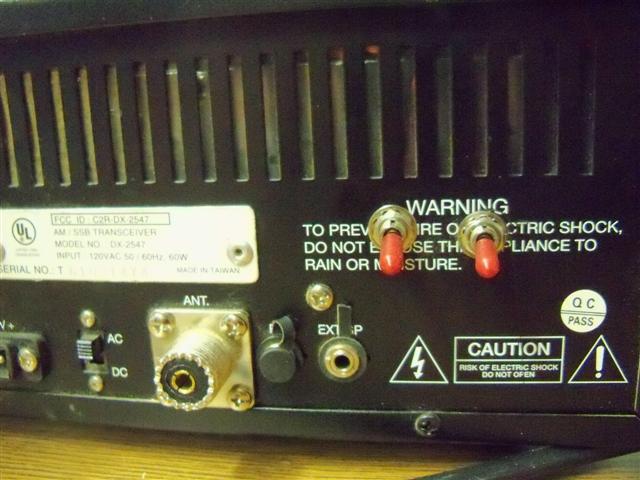
The radio does have some small flip out feet in the front that you can set up to angle the radio up for viewing. While it really isn’t necessary for operation it can be nice to have a bit of an angle if you sit close to the radio. These feet are notorious for breaking off though to be careful moving the radio around.
959 IN A BOX
One of the discussions I’ve heard from people regarding this radio is “Why would I buy that radio, it’s just a 959 in a base box?”.
They are absolutely correct. The Galaxy DX 2547 does use the Galaxy 959 circuit board and inside the adjustment points look identical. And while the radios are very similar in options and functions I think the argument is flawed.
People buying this radio are doing so because they want a radio with a built in power supply. They also are looking for a radio that has the face and features laid out in a format that is easy to use in a desk environment. Additionally this radio does have a six digit frequency counter unlike the 959 which only sports a 5 digit counter making it popular with many of the SSB operators.
And while you could buy a Galaxy 959 and a separate power supply and have a similar setup CB companies have been putting mobile radios inside base cases for many years. In fact most of the popular older base radios by Cobra and Uniden are prime examples of this and no one seems to ever complain about those radios being the same as their mobile counterparts.
I will point out the biggest difference I found when operating the Galaxy DX 2457 versus the Galaxy 959 in a base environment. The 2547 was a much more stable radio in regards to frequency drift. Even though it uses the same board and layout as it’s mobile cousin I found that the radio drifted less during use which might be attributed to the built in power supply and regulator. Now I wish I could say it didn’t drift at all but I found with this base station it did have a 7-10 minute warm up period before it reached it’s operating temperature and once it reached that point it might drift off very slightly every 15-20 minutes. For this radio and the Galaxy 959 I’d recommend performing a modification and unlocking the clarifier so the radio will track on receive and transmit. If you like to be able to turn the radio on and transmit on 27.3850 thirty seconds later I think unlocking the clarifier on these radios is a must. Since the radio has a active frequency counter it makes it easy to choose where you want to transmit and key.

RECEIVE AND TRANSMIT
The radio has excellent receive abilities and I found it had no problems picking up distant locals or stations far off in DX land. I compared it against a PC122XL, Cobra 146, and Magnum 257 I had on my desk and it was able to hold it’s own with those other popular models.
While I was working some good SSB DX I began to experiment with the variable tone control and found that once I adjusted it to the low end I could eliminate almost all of the background hiss and with the ANL and NB activated the radio was very quiet and easy on the ears – a big plus in a home environment. The tone control definitely makes this possible and while without it the receive sound might be average I think having this control on the radio definitely makes listening more enjoyable.
Transmit testing on the radio showed a 4 watt deadkey with swing up to around 18 watts with solid modulation. From a 1 watt deadkey we would see about 12-15 watts swing. The radio we tested did have a speech processor installed and so it’s difficult to say exactly what the output or modulation would have been on a stock model (we may have to order a stock one in just for comparison) but I can say that the radio easily reached 100% modulation with our desk mike during testing.
I paired this radio with the Galaxy Echo/Roger Beep Amplified Desk microphone and that’s when the local reports really started glowing. The Galaxy desk mike is very loud normally and when matched up with this radio locals said it sounding loud and clear on both AM and SSB. I have to say that after testing multiple radios with the Galaxy desk mike (most recently a 93T this week) that this particular desk mike is definitely worth owning if you want some punch on your radio.
Just for interest sake I did try running the Galaxy DX 2547 in conjunction with a small amplifier and it drove the amp very well. For those who intended to use one of these with a 2 x 1446 or 2 x 2879 amplifier I think you’ll have good results.
In testing there weren’t any issues with over-modulation or distortion although I can remember a couple of years ago I did hear a local guy on the air running a 2547 with the modulation limiter clipped and a D104 and it sounded terrible so I definitely don’t recommend removing limiters in this radio.
SUMMARY
Base station CB radios have all but disappeared from the landscape and the lone survivor these days is the Galaxy DX 2547. I suspect it won’t be long before production on these radios ends and the days of the CB base radio will be over. Now that doesn’t necessarily mean you need to run out and buy one of these, but if you’ve been in the market for a base CB for a while then it might not be a bad time to pick one up (or you could wait till they eventually go on closeout).
Overall I give the radio a thumbs up. It’s easy to use, has nice controls and all the functions you’d need from a CB radio and more. The six digit frequency counter is great, the variable power is useful and the tone control can really cut out the hiss. We got good audio reports and the radio had good swing and output. It’s easy to modify for extra frequencies and the radio and board are well documented online with instructions for alignments and mods.
The negatives – the flip up feet underneath are well known for breaking off (I actually broke one during my testing). It didn’t escape the typical Galaxy drift issues although it’s more stable than the 959 in a base environment. The Galaxy noise feature doesn’t really do anything. Lastly – the radio’s aren’t cheap (the lowest we saw was for around $269).
While the DX 2547 may not have the allure of the famous Cobra 2000 GTL it can definitely hold it’s own as far as features are concerned and it takes up about half the desk space. If you have the money and don’t mind owning an export radio I’d probably say step up to a microprocessor controlled base like the RCI 2995DX, but for those looking for a good CB radio that can just about everything you need the 2547 is a fun radio to own.
And for those who don’t like the styling ( I have to say I initially didn’t like it the first time I saw it years ago) once you start using one in person it’s hard not to warm up to the looks and feel of this model. I actually felt a little sad when the review was over and it was time to sell it to fund the next project.
————————————————————————————————————
GALAXY PREMIUM FEATURES:
New Style Midsize Chassis:
4-3/4″H x 11-1/4″W x 13-1/2″D – 12 lb.
Operates on both AC and DC
Six Digit Frequency Counter
Large, easy-to-read meter with 4 scales:
“S” Meter indicates up to 60 dB over S9
Modulation Percentage Scale for use on AM
Power Scale Calibrated for AM and SSB
SWR Scale
Automatic SWR Circuit (no complicated calibration procedure)
Talkback Circuit with On/Off Switch and Volume Control
Variable Power Output Control
Roger Beep with On/Off switch and LED Indicator
Galaxy Noise Filter for use on weak signals
High SWR Alert LED Indicator
Instant Access to Channel 9 or 19
Receive Clarifier with On/Off Switch
Tone Control for Receive
Flip-Down Front Feet
Powered Pin on Mic Jack
Complete soft-cover Service Manual including Schematic Diagrams enclosed with each radio (in addition to the standard operating manual)
Two Year Warranty
ADDITIONAL FEATURES:
AM, SSB and PA Modes
LED Channel Indicator
Green/Red LED Indicator for RX/TX
1/4″ Headphone Jack on Front Panel
Jacks for PA and External Speaker on Rear Panel
Noise Blanker with On/Off Switch
Automatic Noise Limiter with On/Off Switch
Dimmer Control with On/Off Switch
Receive Gain Control
Mic Gain Control
Handheld Microphone
DX 2547 Specifications
GENERAL
Model DX 2547
Frequency Range 26.965 – 27.405 MHz (40 Channels)
Emission Modes AM/USB/LSB
Frequency Control Phase Lock Loop (PLL) Synthesizer
Frequency Tolerance 0.005 %
Frequency Stability 0.001 %
Operating Temperature Range -30°C to +50°C
Microphone Dynamic PTT, 500 Ohms
Input Voltage (DC/AC Selectable) 13.8V DC / 110V AC 60Hz
Current Drain: Transmit (AM full mod.) < 3.5A
Current Drain : Receive (Squelched) £ 0.5A
Current Drain : Receive (Max. audio output) < 1A
Antenna Connector UHF; SO239
Dimensions 4-3/4″H x 11-1/4″W x 13-1/2″D
Weight 12 lb.
TRANSMITTER
RF Power Output AM : 4W / SSB : 12W PEP
RF Transmit Modes AM/SSB
Modulation High and Low level Class B, Amplitude Modulation : AM and SSB
Spurious Emissions -60 dB
Carrier Suppression -60 dB
Audio Frequency Response 300 to 2500 Hz
Antenna Impedance 50 Ohms
Output Indicators Meter shows relative signal strength, RF output power, SWR and AM Modulation level. Transmit LED glows red when transmitter is in operation.
RECEIVER
Sensitivity for 10dB S/N (AM/ SSB) < 0.5 mV / < 0.15 mV
IF Frequency AM: 10.695 MHz 1st IF, 455 KHz 2nd IF
Image Rejection -50 dB
Adjacent Channel Selectivity -60 dB
RF Gain Control 45 dB adjustable for optimum signal reception
Automatic Gain Control (AGC) Figure of Merit 100 mV for 10 dB Change in Audio Output
Squelch Adjustable; threshold less than 0.5 mV
Noise Blanker RF type
Audio Output Power 2.5W @ 10% THD
Audio Frequency Response 300 to 2500 Hz
Built-in Speaker 8 Ohms, 4 Watts
External Speaker (Not Supplied) 8 Ohms, 4 Watts
(SPECIFICATIONS SUBJECT TO CHANGE WITHOUT NOTICE)
ADDITIONAL PICTURES




